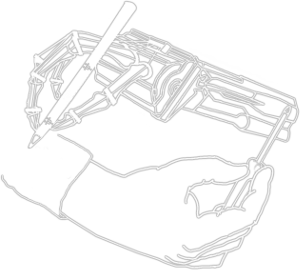Variable Thumb Moment Arm Modeling and Thumb-Tip Force Production of a Human-Like Robotic Hand. Journal of Biomechanical Engineering 139, 101005 (2017).
Using a System-Based Monitoring Paradigm to Assess Fatigue during Submaximal Static Exercise of the Elbow Extensor Muscles. Sensors (2021).
An Upper-Body Rehabilitation Exoskeleton Harmony with an Anatomical Shoulder Mechanism: Design, Modeling, Control, and Performance Evaluation. International Journal of Robotics Research (IJRR) 36, 414-435 (2017).
A unified framework to represent physically cooperating mobile robots and other robotic systems. Robotics Science and System (2006).
Understanding variable moment arms for the index finger MCP joints through the ACT hand. Biomedical Robotics and Biomechatronics, 2008. BioRob 2008. 2nd IEEE RAS & EMBS International Conference on 776–782 (IEEE, 2008).
Understanding the Mechanisms of Scapulohumeral Rhythm with the HARMONY Exoskeleton. Biomechanics and Neural Control of Movement (BANCOM) (2016).
Synthesis of Gait Kinematics Using a Database. Dynamic Walking (2013).
Subject-specific Assist-as-needed Controllers for a Hand Exoskeleton for Rehabilitation. IEEE Robotics and Automation Letters (RA-L) 3, (2018).
Statistical method for prediction of gait kinematics with Gaussian process regression. Journal of Biomechanics 47, 186–192 (2014).
Statistical Functional Mapping From Body Parameters to Gait Kinematics. American Society of Biomechanics (2013).
A Simulation Framework for Virtual Prototyping of Robotic Exoskeletons. Journal of Biomechanical Engineering 138, (2016).
Series Elastic Actuators for Small-Scale Robotic Applications. Journal of Mechanisms and Robotics 9, (2017).
SCAPE: Learning Stiffness Control from Augmented Position Control Experiences. Conference on Robot Learning. Proceedings of Machine Learning Research (2021).
SCAPE: Learning Stiffness Control from Augmented Position Control Experiences. Proceedings of the 5th Conference on Robot Learning () (PMLR, 2022). at <https://proceedings.mlr.press/v164/kim22b.html>
The Road Forward for Upper Extremity Rehabilitation Robotics. Current Opinion in Biomedical Engineering (2021).
Quantifying Changes in Kinematic Behavior of a Human-Exoskeleton Interactive System. 2022 IEEE/RSJ International Conference on Intelligent Robots and Systems (IROS) (2022). doi:10.1109/IROS47612.2022.9981032
A Novel Joint Design for Robotic Hands with Human-Like Nonlinear Compliance. Journal of Mechanisms and Robotics (2015).
A Novel Inverse Kinematics Method for Upper-Limb Exoskeleton under Joint Coordination Constraints. IEEE/RSJ International Conference on Intelligent Robots and Systems (IROS) (2020).
A novel framework for virtual prototyping of rehabilitation exoskeletons. Rehabilitation Robotics (ICORR), 2013 IEEE International Conference on 1–6 (IEEE, 2013).
A Novel Framework for Optimizing Motor (Re)-Learning with a Robotic Exoskeleton. Biomechanics and Neural Control of Movement (BANCOM) (2016).
Novel design of a passive variable stiffness joint mechanism: Inspiration from biomechanics of hand joints. ASME 2013 Dynamic Systems and Control Conference V002T28A003–V002T28A003 (American Society of Mechanical Engineers, 2013).
A Novel Control Law for Multi-Joint Human-Robot Interaction Tasks While Maintaining Postural Coordination. 2023 IEEE/RSJ International Conference on Intelligent Robots and Systems (IROS) (2023). doi:10.1109/IROS55552.2023.10342501
Novel Biomedical Technologies: Rehabilitation Robotics. Current Opinion in Biomedical Engineering 22, (2022).
Muscle-tendon units provide limited contributions to the passive stiffness of the index finger metacarpophalangeal joint. Journal of biomechanics 45, 2531–2538 (2012).
Monitoring Human Neuromusculoskeletal System Performance during Spacesuit Glove Use: A Pilot Study. IEEE Aerospace Conference (2018).
Monitoring Fatigue-Induced Changes in Performance during Robot-Mediated Dynamic Movement. IEEE International Conference on Robotics and Automation (ICRA) (2021).
A Modular Design for Distributed Measurement of Human-Robot Interaction Forces in Wearable Devices. Sensors (2021).
Mirrored movement therapy using an upper body robotic exoskeleton for stroke. 2017 International Symposium on Wearable Robotics and Rehabilitation (WeRob) (2017).
Methodology of an Inverse Kinematic Model for Estimating Shoulder Girdle Angles without Acromial Sensing. 48th International Conference on Environmental Systems (2018).
A methodology for kinematics and dynamics analysis of robotic systems internal actuation. ASME 2007 International Mechanical Engineering Congress and Exposition 1361–1367 (American Society of Mechanical Engineers, 2007).
A methodology for design and analysis of cooperative behaviors with mobile robots. Autonomous Robots 27, 261–276 (2009).
Methodologies for determining minimal grasping requirements and sensor locations for sEMG-based assistive hand orthosis for SCI patients. IEEE International Conference of Rehabilitation Robotics (ICORR) (2017).
A method to characterize and exploit actuation redundancy in mobility and manipulation. Intelligent Robots and Systems, 2007. IROS 2007. IEEE/RSJ International Conference on 3515–3521 (IEEE, 2007).
A Method for the Analysis of Physical Human Robot Interaction. IEEE/ASME International Conference on Advanced Intelligent Mechatronics (AIM) (2021).
Mechanisms of the anatomically correct testbed hand. Mechatronics, IEEE/ASME Transactions on 18, 238–250 (2013).
Mechanical Design of A Wearable Robot for Upper Body Rehabilitation. International Workshop on Wearable Robotics (WeRob) (2014).
Kinematics and Dynamics of a Biologically Inspired Index Finger Exoskeleton. ASME 2013 Dynamic Systems and Control Conference V002T28A001–V002T28A001 (American Society of Mechanical Engineers, 2013).
Kinematic coordinations capture learning during human-exoskeleton interaction. Scientific Reports 13, (2023).
Kinematic comparison of single degree-of-freedom robotic gait trainers. Mechanism and Machine Theory (2021).
Intelligent Strategies for the Application of the Constraint Dominance Methods: Demonstration with Linear Motor Design Problem. Artificial Intelligence for Engineering Design, Analysis and Manufacturing (AIEDAM), Special Issue on Constraints and Design 20, 383–397 (2006).
Integration of Musculoskeletal Analysis with Engineering Design for Virtual Prototyping of Exoskeletons. American Society of Biomechanics (2013).
On Integration of Additive Manufacturing During the Design and Development of a Rehabilitation Robot: A Case Study. Journal of Mechanical Design (2015).
The Influence of Robotic Assistance on Reducing Neuromuscular Effort and Fatigue during Extravehicular Activity Glove Use. International Conference on Environmental Systems (ICES) (2017).
An Index Finger Exoskeleton with Series Elastic Actuation for Rehabilitation: Design, Control and Performance Characterization. International Journal of Robotics Research (IJRR) 34, (2015).
Improvement of Hand Functions of SCI Patients with EMG-driven Hand Exoskeleton: a Feasibility Study. Wearable Technologies (2021).
Impedance Control Based on a Position Sensor in a Rehabilitation Robot. ASME Dynamic Systems and Control Conference (DSCC) (2014).
Impedance and Force-Field Control of the Index Finger Module of a Hand Exoskeleton for Rehabilitation. Rehabilitation Robotics (ICORR) 85–90 (IEEE, 2015).
Impact of Gravity Compensation on Upper Extremity Movements in Harmony Exoskeleton. International Conference on Rehabilitation Robotics (ICORR) (2022).
Impact of Gravity Compensation on Upper Extremity Movements in Harmony Exoskeleton. 2022 International Conference on Rehabilitation Robotics (ICORR) (2022). doi:10.1109/ICORR55369.2022.9896415
Human-Robot Interaction: Muscle Activation and Angular Location Affect Soft Tissue Stiffness. IEEE RAS/EMBS International Conference on Biomedical Robotics and Biomechatronics (BioRob) (2022).


 ]
]